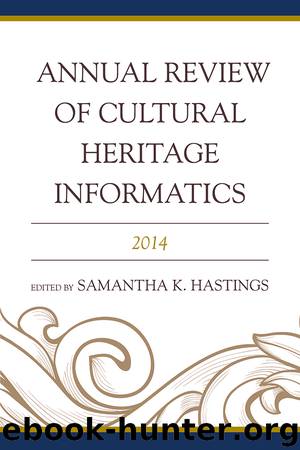Annual Review of Cultural Heritage Informatics : 2014 by Hastings Samantha K

Author:Hastings, Samantha K. [Hastings, Samantha K.]
Language: eng
Format: epub
Publisher: Rowman & Littlefield Publishers
Published: 2015-04-08T04:00:00+00:00
7
Social Media and Participatory Culture
Opportunities and Challenges for Reforming the Contemporary Museum
Stan A. Trembach and Liya Deng
Abstract
The purpose of this chapter is to explore social media as a cultural phenomenon that has revolutionized the relationship between contemporary museums and their users. The authors draw on a variety of scholarly sources to conduct a critical analysis of the advantages and disadvantages of various social media platforms for museum audience development and engagement. It is argued that by establishing a presence in this growing universe, museums can build a more robust marketing strategy and capitalize on social media’s untapped potential for creating participatory learning environments. However, the use of social media in museum practice also raises concerns about user privacy, identity, and accountability, along with issues of cultural authority and the authenticity of museum objects. Through an examination of the current cultural scholarship, the chapter demonstrates how a thoughtful approach to the use of social media tools may position museums for long-term sustainability and success during the current economic recession and beyond.
Introduction
In recent decades, the nature of communication has evolved dramatically due in large measure to the indelible impact of information and communication technologies (ICTs), particularly social media, on every aspect of human existence. Social media have been immersed in our lives by gradually being introduced into a range of professional and cultural fields. Museums are also starting to come to the forefront of the media revolution by enthusiastically embracing new formats of user-to-user and user-to-all interaction afforded by social media. In light of the fact that the impact of social media on socioeconomic and political structures has long been in the spotlight of scholarly attention, the role of social media in the intellectual and cultural spheres is worthy of an equally scrupulous examination. There are both philosophical and practical considerations for why these technologies are winning over the museum world. It may have been a painstaking process, but museums are finally talking about social media, albeit sometimes with mixed feelings of love, hate, curiosity, or indifference (Wong, 2012). No matter the attitude, such a wide range of emotions shows genuine interest on museums’ part in the promise of social media, which is a positive sign for the future.
Given that possible applications of media technologies have already generated considerable conversation in the cultural arena, this chapter intends to extend the discussion even further based on the premise that the impact of technology goes beyond transforming the algorithms of information exchange. Our thought process and the way we perceive communication as a daily activity have also changed as a result. As more and more people turn to the Internet for professional and social purposes, we are witnessing a revolutionary growth of new places for communication to transpire and new avenues for users to interact. Therefore, it is hardly surprising that social media have by now paved their way into the mainstream of innovative communication means. Due to their ubiquity and increasing accessibility, particularly with the younger generations, social media have left an imprint on practically every walk of life.
Download
This site does not store any files on its server. We only index and link to content provided by other sites. Please contact the content providers to delete copyright contents if any and email us, we'll remove relevant links or contents immediately.
The Brazilian Economy since the Great Financial Crisis of 20072008 by Philip Arestis Carolina Troncoso Baltar & Daniela Magalhães Prates(105596)
International Integration of the Brazilian Economy by Elias C. Grivoyannis(75378)
The Art of Coaching by Elena Aguilar(52196)
Flexible Working by Dale Gemma;(23212)
How to Stop Living Paycheck to Paycheck by Avery Breyer(19567)
The Acquirer's Multiple: How the Billionaire Contrarians of Deep Value Beat the Market by Tobias Carlisle(12112)
Thinking, Fast and Slow by Kahneman Daniel(11798)
The Radium Girls by Kate Moore(11624)
The Art of Thinking Clearly by Rolf Dobelli(9919)
Hit Refresh by Satya Nadella(8859)
The Compound Effect by Darren Hardy(8522)
Atomic Habits: Tiny Changes, Remarkable Results by James Clear(8053)
Tools of Titans by Timothy Ferriss(7818)
Turbulence by E. J. Noyes(7704)
Change Your Questions, Change Your Life by Marilee Adams(7381)
A Court of Wings and Ruin by Sarah J. Maas(7269)
Nudge - Improving Decisions about Health, Wealth, and Happiness by Thaler Sunstein(7247)
How to Be a Bawse: A Guide to Conquering Life by Lilly Singh(7158)
Win Bigly by Scott Adams(6829)
